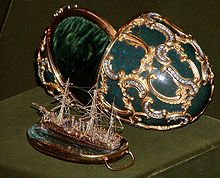- Memory of Azov Egg
-
Memory of Azov Fabergé egg 
Memory of Azov EggYear delivered 1891 Customer Maria Feodorovna Current owner Individual or institution Kremlin Armoury, Moscow Design and materials Workmaster Michael Perkhin and Yuri Nicolai Materials used bloodstone, ruby, diamonds, gold, platinum, aquamarine Height 9.3 centimetres (3.7 in) Surprise replica cruiser Pamiat Azova The Memory of Azov Egg (or the Azova Egg) is a jewelled Easter egg made under the supervision of the Russian jeweller Peter Carl Fabergé in 1891 for Tsar Alexander III of Russia. It was presented by Alexander III as an Easter gift to his wife, the Czarina Maria Feodorovna. It is currently held in the Kremlin Armoury Museum in Moscow, and it is one of the few Fabergé eggs that have never left Russia.
Contents
Design
Carved from a solid piece of heliotrope jasper, also known as bloodstone, the Memory of Azov Egg is decorated in the Louis XV style with a superimposed gold pattern of rococo scrolls with brilliant diamonds and chased gold flowers. The broad flute gold bezel is set with a drop ruby and two diamonds that complete the clasp. The egg's interior is lined with green velvet.
Surprise
The surprise contained within is a miniature replica of the Imperial Russian Navy cruiser Pamiat Azova (Memory of Azov), executed in red and yellow gold and platinum with small diamonds for windows, set on a piece of aquamarine representing the water. The name "Azov" appears on the ship's stern. The plate has a golden frame with a loop enabling the model to be removed from the egg.
History
For more details on this topic, see Eastern journey of Nicholas II.The egg commemorates the voyage made by Tsarevitch Nicholas and Grand Duke George of Russia aboard the Pamiat Azova to the Far East in 1890. The trip was made after a suggestion by their parents to broaden the outlook of the future Tsar and his brother. At the time, Grand Duke George was suffering from tuberculosis, and the voyage only exacerbated it. Tsarevitch Nicholas was also the victim of an attempted assassination ("Ōtsu incident") whilst in Japan and sustained a serious head wound. Although the Tsarina was presented with the egg before these events occurred, it apparently was never one of her favourite eggs.
See also
References
- Faber, Toby. Faberge's Eggs: The Extraordinary Story of the Masterpieces That Outlived an Empire. Random House (2008) ISBN 140006550X
- Forbes, Christopher and Johann Georg Prinz von Hohenzollern. FABERGE; The Imperial Eggs. Prestel (1990). AISN B000YA9GOM
- Lowes, Will. Fabergé Eggs: A Retrospective Encyclopedia. Scarecrow Press (2001) ISBN 0810839466
- Snowman, A Kenneth. Carl Faberge: Goldsmith to the Imperial Court of Russia. Gramercy (1988) ISBN 0517405024
External link
Categories:- Fabergé eggs
- Visitor attractions in Moscow
- 1891 works
Wikimedia Foundation. 2010.
